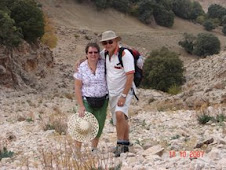I wrote this on the 10th November at the Toyota
Workshop in Trujillo (coast of Peru) whilst having the timing belt replaced
plus some bushes on the rear suspension that must have got damaged on one of
the many rocky roads we have been on. Unfortunately the internet was not good
enough to download it and we have been in the mountains with no internet until
today, so rather than update it I send this as at 10th November.
I ended the last blog at the museum in Lambayeque because I
wanted my audience fresh for some amazing photos.
After the museum we headed back to the coast to visit more
archaeological sites. They have found evidence of habitation in Peru for 10,000
years. Everyone has heard of the Incas, but they did not exist until 1400’s,
spreading north and south from Cuzco, conquering the whole of the area from
Northern Chile to Southern Colombia and taking control of cities that had
existed since the first century.
It is interesting that as the king returned to Cusco from
taking southern Columbia he was attacked by his brother who was ruling the
south. The king was victorious but at this point the Spanish arrived and the
southern kingdom supported the Spanish as they saw them as their saviours,
otherwise the outcome could have been very different.
It is also interesting that in Tucame (in the Chiclayo area)
the Moche (100 – 800) built Pyramids, but when they had major sand storms or
massive floods (usually caused by El Nino), they would destroy the temple and
build another one. But in the Trujillo area, the Chimu (800 to 1400) built the
temples of the Sun and the Moon, but they would fill in the temple with 000’s
of mud bricks after a natural disaster and build another in exactly the same
style on top. The Chimu conquered the Moche in 800 and the Incas conquered them
around 1400, but only lasted about 80 years before the Spanish arrived (all
dates are approximate, give or take 100 years or so).
The problem with all of these Pyramids is that they were
basically made of mud and by combination of drifting sand and torrential rain
they are almost unrecognisable, looking more like small hills dotted around.
Many are in a very early stage of excavation and with the exception of Chan
Chan and the Temple of the moon there is not a lot to see and really only at
the Temple of the moon do you really get an inkling of what they must have
looked like.
We now head a bit further south to a 2,500 year old city.
And then back into the mountains, the coast is mostly desert, very dusty and not
a lot to see from here on down, so we will probably stay in the mountains right
into Bolivia.
 |
| I cannot believe these people were actually dead by the expressions on their faces!!! I am not sure which era they belong too as there were lots of them in a temperature controlled room (and not supposed to be photographed, but I had to sneak a couple for my readers), but somewhere between 600 and 2000 years old. They had to be buried in this position to fit the spaces they made for them! |
 |
| These ornaments are from the Chimu era, around 1,300 years old |
 |
| One of the many Pyramids at Tucame, but unfortunately not a lot to see. |
 |
| Camped opposite a Hostel, right on the cliff edge |
 |
| With an amazing view |
 |
| And an amazing sunset |
 |
| These canoes have been in use for 1,000's of years |
 |
| And still in use today, the hole in the back is for stowing their catch and they either kneel or straddle the canoe. |
 |
| Removing his catch |
 |
| Chan Chan (near Trujillo) |
 |
| 1,300 year old earthquake proof walls, still in tact. |
 |
| Chris stands at the entrance of one of the Temples near Chan Chan |
 |
| The Temple of the Sun (yet to be excavated), taken from the top of the Temple of the Moon, with the remains of the city in between |
 |
| An artists impression of what it actually looked like |
 |
| A model of a typical dwelling |
 |
| The Sacrificial Alter - human sacrifices were made to appease the gods to avoid natural disasters. They were chosen by combat in a special arena within the temple, the losers were sacrificed! |
 |
| What it actually looked like |
 |
| The rear wall of the arena |
 |
| Artists impression (and shows 7 different levels, each one filled in and built on top of. |
 |
| A Peruvian Hairless dog (except the tuft on its head) |
 |
| A couple of tortoises at our camp site - large, but not to Galapagos standards |
 |
| The little one liked to have its head scratched (and also like to bite my toe if I wasn't looking) |
 |
| Joined by a couple of Overland Monsters, one form Spain and one from Chile. Fuel consumption on these things is about 1 mile per litre! |
 |
| Our soup set me a real mathematical conundrum! Everyone had a bowl of soup with a chicken claw. Main couses were a choice of pork, beef fish or chicken and a chicken would do at least 8 meals. Conclusion, they must have a lot chickens running around with no feet! |


































No comments:
Post a Comment